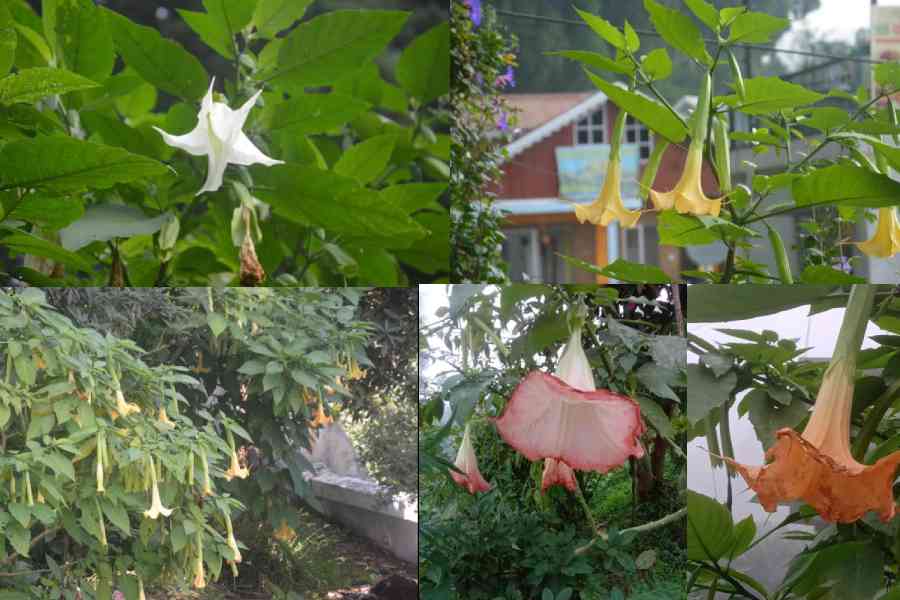They are trumpet-shaped; they smell sweet and intoxicating; they come in a large palate of colours and above all their huge size adds to their dramatic beauty. Meet Angel’s Trumpet, that is a favourite of growers and admirers alike.
Angel’s Trumpet or Brugmansia is a tender shrub or a small tropical tree with large semi-evergreen leaves in the family Solanaceae (potato/ tomato/ eggplant) that produces fragrant, trumpet-shaped, pendant spectacular flowers. They can grow up to 15-20 feet tall when grown outdoors but adapt well to container culture.
Brugmansia is native to South America and like warm, humid days and cool nights. It is a long-lived perennial. There are several species, many of which have been hybridised to create spectacular cultivars. Individual blooms range in size from four to 24 inches long depending on the species/cultivar.
Types of trumpets
They come in many shades of white, yellow, gold, orange, peach and pink. There are singles, doubles, triples, and quadruples and a few shredded forms too. There is also a variety of funnel and trumpet shapes. Some cultivars bloom throughout the growing season, others flower in flushes every six to eight weeks, while some only produce flowers in cool weather. Some produce lots of flowers while others have few flowers.
At one time these plants were included in the genus ‘Devil’s Trumpet’ (Datura) but taxonomists have divided the two groups into different genera. Brugmansias are a long-lived, woody perennial, in time reaching heights of over 20ft. They have downward to slightly outward-facing, large (six to 24 inch) trumpet-shaped blooms, in shades of white, cream, yellow, peach, orange, pink, and red and rarely set seed, that is it does not produces seeds through the process of reproduction.
In contrast, Daturas are a short-lived herbaceous perennial. They rarely live more than three to four years and rarely exceed heights over six feet. Their smaller (two to eight inch long) white, cream, yellow, lavender or purple flowers are held upright above the plants and set seed freely.
There are many species and hundreds of cultivars and hybrids of Brugmansia. Some of the more common and interesting ones include Brugmansia arborea (the smallest flowers), Brugmansia Charles Grimaldi (fragrant, golden colour), Brugmansia Cypress Gardens (best for containers, white flowers), Brugmansia Ecuador Pink (deep pink flowers), Brugmansia Inca Sun (light yellowish peach), Brugmansia Jamaican Yellow (very fragrant, lemon yellow flowers), Brugmansia Sanguinea (red flowers, non-fragrant), Brugmansia Versicolor (pale apricot flowers, largest flower), Brugmansia X Candida Shredded White (double white flowers, petals are twisted, divided, with curly tendrils), Brugmansia X Insignis Pink (eight to 10 inch-sized flowers, pale pink).
Light, soil and water
Angel Trumpet grows best in full sun, in hot climates; protect the plant from direct sun. Give it some shade, like morning sun and afternoon shade, or dappled sun.
Use organically rich, moist, well-drained soils. Water them regularly and thoroughly but they don’t like wet feet. Angel Trumpet flowers are a good indicator plant. They will wilt and let you know when they are dry. They are highly drought-tolerant.
Fertiliser
Angel Trumpet’s 12-inch-long blooms are one of its most impressive features. These beautiful plants bloom a lot and will thrive with regular all-purpose fertilisation that will keep the blooms and foliage at their best.
Pruning
The Angel Trumpet flower is hardy and takes well to pruning, so go ahead to make drastic cuts. Early March is the best time to trim and shape them so they can produce new foliage and beautiful flowers. Pruning is useful for managing the plant’s growth, but can also be used as an opportunity to control its shape. Use clean, sharp tools for pruning. If there’s less air circulation, it can make conditions pest-prone.
Common pests and diseases
Angel Trumpet can be infected by common garden pests, caterpillars, spider mites, aphids, whiteflies and mealy bugs. Spray them with weekly applications of horticulture oil, neem oil, or insecticidal soap. It is best to use horticulture oil one week and insecticidal soap the next to reduce the chances of pesticide resistance.
Propagation
Propagate angel trumpet with six to eight inch-long and at least the diameter of half-inch section cuttings taken in early March. Dip them lightly in root hormone. Leave an inch of small leaves at the top of the stem, but remove the rest. Plant them in the wet sand.











